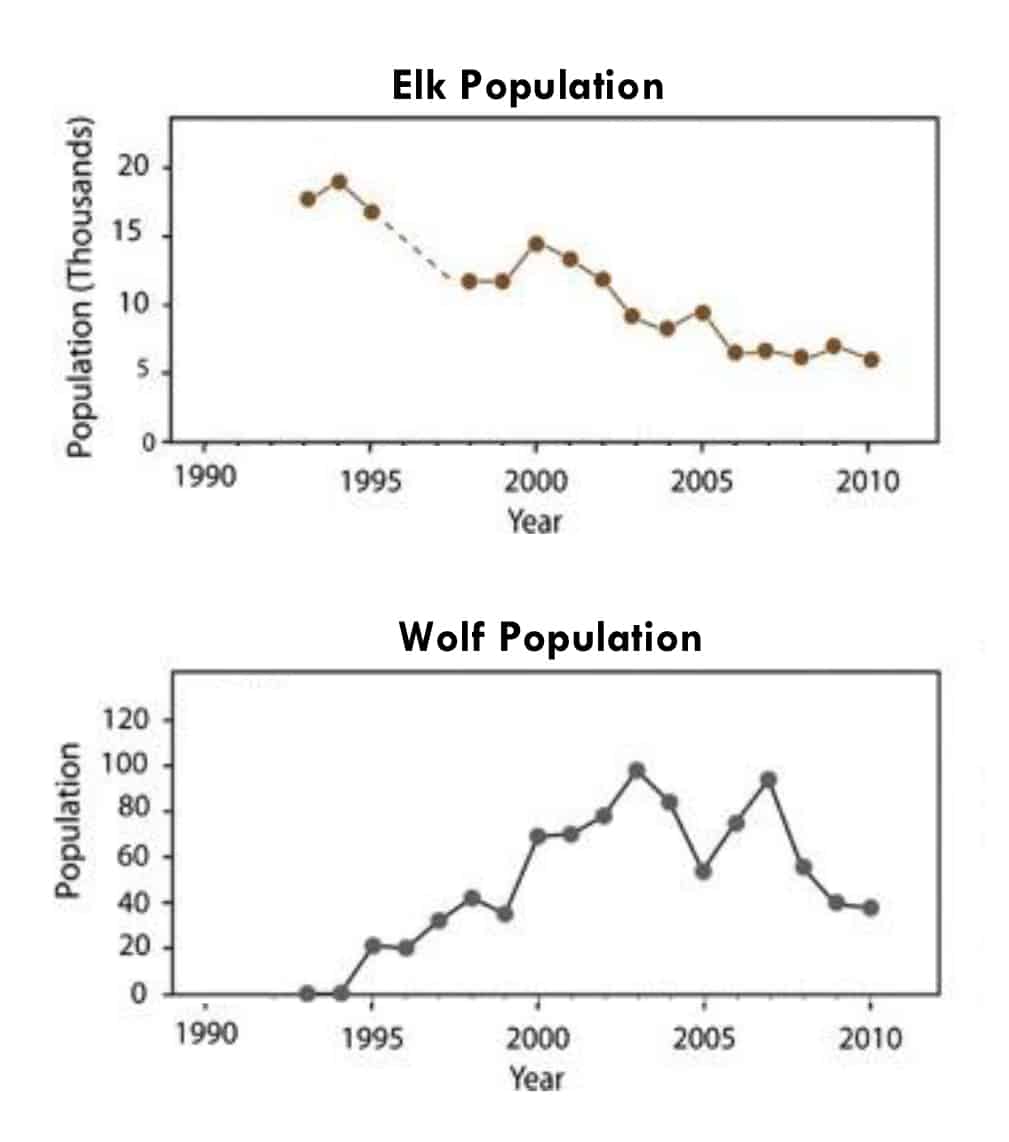explore
Yellowstone Without Wolves
How did the absence of wolves impact the Yellowstone National Park ecosystem?
Wolves are the top, or apex, predator of their ecosystem because they have no natural predators in their food web. Removing a top predator like the wolf can create a chain reaction of effects on other species in the web, referred to as a trophic cascade. Wolf reintroduction into Yellowstone National Park offers a powerful case study to learn from. Decades of scientific research paint a picture of the wolf’s impact on its ecosystem and people, both during its absence and once it returned. Let’s start by going back in history to figure out when wolves were thriving in Yellowstone, when and why they were eliminated, and the impact that their elimination had on the park ecosystem.
Original lesson resource: Activities on this page are adapted from Wolves of Yellowstone Teacher Guide, a free curriculum developed by PBS Learning Media and The Nature Conservancy that you can download. Refer to p. 1-11 for the activities on this page.

How does a trophic cascade help explain the effects of wolves being eliminated from Yellowstone?
When the wolves of Yellowstone National Park were removed, the ecosystem started to change. What happened, and why? Watch the first part of this video to figure out how the absence of wolves impacted the ecosystem. It describes the phenomenon scientists call a trophic cascade. Scientists are still building on this research as they continue to investigate the effects of the wolf’s absence, and return, on the Yellowstone ecosystem.
Make Sense of This Video
- Map out this ripple effect of change that happened through the ecosystem when the food web’s top-predator trophic level was eliminated.
- Watch the first part of the Video: Wolves of Yellowstone: A New Wild video clip from 0-2:36 minutes.
- Draw a bubble concept map that shows how removing wolves caused changes to other parts of the ecosystem. To start your map, write “Wolves removed” in the central bubble, and build out from there.
- Watch the video segment several times to make sure you catch and record all the connections described.
- Search your bubble concept map for examples of food chains. Draw a visual model of these food chains, including an explanation of how they were a part of this trophic cascade when wolves were eliminated. Consider labeling producers, primary consumers/herbivores, secondary consumers/carnivores or omnivores.
- How were producers (plants) indirectly affected by the elimination of wolves from the Yellowstone ecosystem?
- Give several examples of how changes to these plants affected different animal species.
- Illustrate in a visual map or write a paragraph describing how the elimination of wolves cascades through the ecosystem to affect water sources.
- Write a hypothesis stating what you think might happen to plant and elk populations when wolves return to Yellowstone. Defend your position. (“If __, then I think __ because __. Supporting evidence includes __.”)

What does the data say?
Let’s look at the plant and animal data scientists collected for the 20-year span from 1990-2010, noting that wolves were reintroduced in 1995. First read the background on the research (Excerpt from Wolves in Yellowstone p. 2), and then analyze the graphs of data.
- Analyze the data: Open and download this handout with the data from the scientific research.
- Reflect on wolves, their ecosystem, and trophic cascades: After analyzing the data, ponder your new insights.
- Write 3 ah-ha’s that you have about wolves and their effects on the ecosystem.
- Write 2 questions you now have related to your new understanding.
- Write 1 personal connection you have made to wolves, their ecosystem, or trophic cascades.

educator note
Driving Question: How did the absence of wolves impact the Yellowstone National Park ecosystem?
What we do on this page:
- Describe the history of wolves in Yellowstone before their reintroduction.
- Create a visual map of a trophic cascade after wolves were eliminated from Yellowstone, and analyze the supporting data.
What we figure out:
- Wolves were native to Yellowstone.
- After wolves were removed from Yellowstone, the ecosystem changed. This change has been called a trophic cascade.
- Scientific data indicates specific changes to parts of the ecosystem after wolves were removed.
Additional resources and ideas:
- Original lesson resource: Activities on this page are adapted from Wolves of Yellowstone Teacher Guide, a free curriculum developed by PBS Learning Media and The Nature Conservancy that you can download. Refer to p. 1-11 for the activities on this page.
- The video Wolves of Yellowstone: A New Wild (5:30 minutes) is divided into two parts. Only show the first half (0-2:36 minutes) for this webpage activity. It talks about Yellowstone without wolves. The second half (2:36-end) describes the park after the wolves were reintroduced, which is the focus of an activity on the next webpage.
- This student handout (Defining Trophic Cascade) was modified for the Quest. The original is here.
